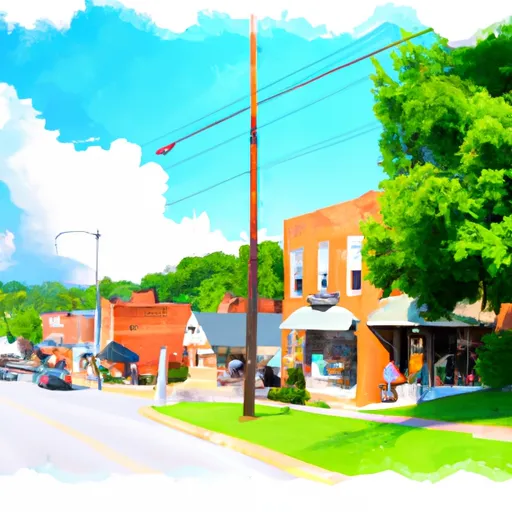-
 Snoflo Premium
Snoflo Premium
Get unlimited access to all our content
With no Ad interruptions! - Start Your Free Trial Login with existing account
Blountville
Eden Index
Climate
8.3
•
Recreation
3.1
•
Community
3.2
•
Safeguard
5.2/10

Blountville, Tennessee, is located in the northeastern part of the state and experiences a humid subtropical climate with hot summers and mild winters. The area is home to several bodies of water, including the South Holston Lake and the Holston River, which provide opportunities for fishing, boating, and kayaking. The region is also known for its scenic hiking trails, such as the Appalachian Trail and the Virginia Creeper Trail, as well as its golf courses and parks. The hydrology constituents of Blountville include the Holston River, which is a source of drinking water for several communities in the area. Additionally, the region is home to a variety of wildlife, including deer, black bears, and various bird species.
What is the Eden Index?
The Snoflo Eden Index serves as a comprehensive rating system for regions, evaluating their desirability through a holistic assessment of climate health, outdoor recreation opportunities, and natural disaster risk, acknowledging the profound impact of these factors on livability and well-being.
Climate Health Indicator (CHI): 8.3
Blountville receives approximately
1081mm of rain per year,
with humidity levels near 83%
and air temperatures averaging around
13°C.
Blountville has a plant hardyness factor of
7, meaning
plants and agriculture in this region tend to thrive during the non-winter months.
By considering the ideal temperature range, reliable water supplies, clean air, and stable seasonal rain or snowpacks, the Climate Health Indicator (CHI) underscores the significance of a healthy climate as the foundation for quality living.
A healthy climate is paramount for ensuring a high quality of life and livability in a region, fostering both physical well-being and environmental harmony. This can be characterized by ideal temperatures, reliable access to water supplies, clean air, and consistent seasonal rain or snowpacks.
Weather Forecast
Streamflow Conditions
French Broad-Holston
Area Rivers
French Broad-Holston
Snowpack Depths
French Broad-Holston
Reservoir Storage Capacity
French Broad-Holston
Groundwater Levels
Recreational Opportunity Index (ROI): 3.1
The Recreational Opportunity Index (ROI) recognizes the value of outdoor recreational options, such as parks, hiking trails, camping sites, and fishing spots, while acknowledging that climate plays a pivotal role in ensuring the comfort and consistency of these experiences.
Access to outdoor recreational opportunities, encompassing activities such as parks, hiking, camping, and fishing, is crucial for overall well-being, and the climate plays a pivotal role in enabling and enhancing these experiences, ensuring that individuals can engage in nature-based activities comfortably and consistently.
Camping Areas
| Campground | Campsites | Reservations | Toilets | Showers | Elevation |
|---|---|---|---|---|---|
| Rock Creek Rec Area | 80 | 2,348 ft | |||
| Persimmon Ridge City Park | 45 | 1,733 ft | |||
| Carolina Hemlocks | 38 | 2,750 ft | |||
| Black Mountain | 48 | 3,005 ft | |||
| Pleasant Ridge County Park | 25 | 1,173 ft | |||
| Patience Park Toe River Campground | 86 | 2,677 ft | |||
| Mount Mitchell State Park | 9 | 6,258 ft | |||
| Paris Mountain State Park | 50 | 1,061 ft | |||
| Warriors Path State Park | 134 | 1,326 ft | |||
| Curtis Creek | 14 | 1,876 ft |
Nearby Ski Areas
Catastrophe Safeguard Index (CSI):
The Catastrophe Safeguard Index (CSI) recognizes that natural disaster risk, encompassing floods, fires, hurricanes, and tornadoes, can drastically affect safety and the overall appeal of an area.
The level of natural disaster risk in a region significantly affects safety and the overall livability, with climate change amplifying these risks by potentially increasing the frequency and intensity of events like floods, fires, hurricanes, and tornadoes, thereby posing substantial challenges to community resilience and well-being.
Community Resilience Indicator (CRI): 3.2
The Community Resilience Indicator (CRI) recognizes that education, healthcare, and socioeconomics are crucial to the well-being of a region. The CRI acknowledges the profound impact of these elements on residents' overall quality of life. By evaluating educational resources, healthcare accessibility, and economic inclusivity, the index captures the essential aspects that contribute to a thriving community, fostering resident satisfaction, equity, and social cohesion.

